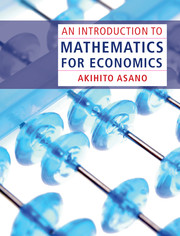Book contents
- Frontmatter
- Contents
- List of illustrations
- List of tables
- Preface
- Acknowledgements
- 1 Demand and supply in competitive markets
- 2 Basic mathematics
- 3 Financial mathematics
- 4 Differential calculus 1
- 5 Differential calculus 2
- 6 Multivariate calculus
- 7 Integral calculus
- Appendix A Matrix algebra
- Appendix B An introduction to difference and differential equations
- Index
6 - Multivariate calculus
Published online by Cambridge University Press: 05 December 2012
- Frontmatter
- Contents
- List of illustrations
- List of tables
- Preface
- Acknowledgements
- 1 Demand and supply in competitive markets
- 2 Basic mathematics
- 3 Financial mathematics
- 4 Differential calculus 1
- 5 Differential calculus 2
- 6 Multivariate calculus
- 7 Integral calculus
- Appendix A Matrix algebra
- Appendix B An introduction to difference and differential equations
- Index
Summary
In Chapter 4, our focus was the firm that maximises its profits. We set up the profit maximisation problem for a firm in a competitive market, and derived its supply function. In doing so, we obtained the first- and second-order conditions, which involved obtaining the first and second derivatives of the profit function, respectively.
In turn, this chapter deals with the consumer's problem. Similar mathematical techniques to those we used in examining the firm's profit maximisation problem will be introduced. The main difference is that, here, we will control two variables instead of one. Recall that, in the firm's maximisation problem, the quantity produced (q) is the only variable that the firm could control, and hence it required differentiating the profit function with respect to one variable (q). In this chapter, we deal with two goods on which a consumer can spend his/her limited income. How should the consumer allocate his/her income to the consumption of each of the goods?
Our fundamental assumption about consumers' behaviour is that they choose a combination of goods they consume so as to maximise their satisfaction. We express the degree of satisfaction by using the term ‘utility’, whose unit of measurement is a ‘util’. We consider a consumer who makes a decision on how much of which goods he/she consumes so as to maximise his/her utility. Our main objective in this chapter is to find the bundle of goods that maximises a consumer's utility, when he/she has a limited amount of income.
Information
- Type
- Chapter
- Information
- An Introduction to Mathematics for Economics , pp. 147 - 183Publisher: Cambridge University PressPrint publication year: 2012
